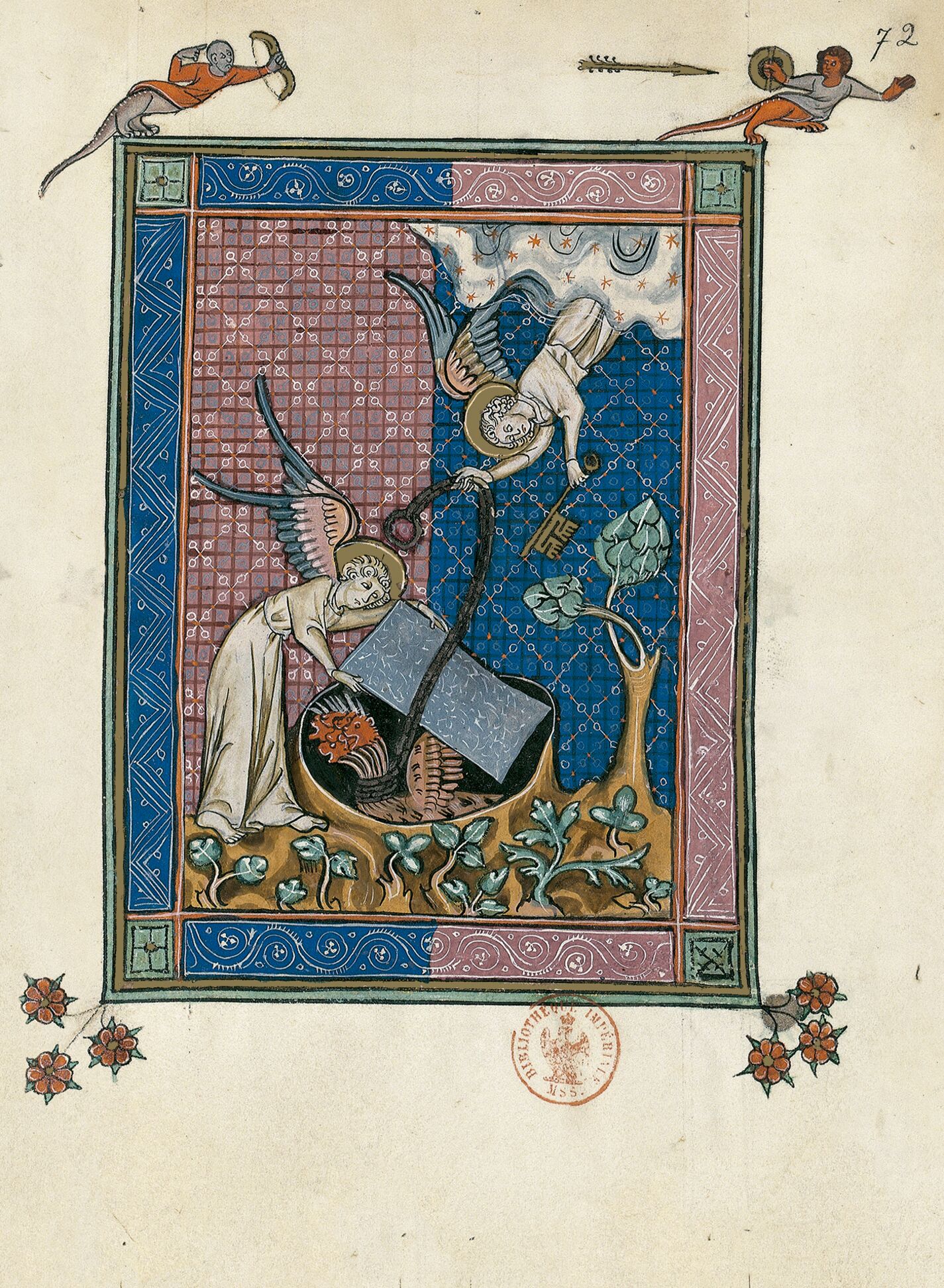It is now the devil’s turn to be rendered harmless for one thousand years, the symbolic duration of peace and pardon for the Church of Christ. The Spirit of God emerges from the clouds and dives towards the earth with a large, gold key in his hands. He holds the ancient Snake, a winged dragon with many heads each topped with a sting, by a long chain around the monster’s neck. The background of this painting, divided lengthwise by two decorative bands in different colours, clarifies the figurative narration, the action of which is depicted on the left of the image, providing an earthly counterpart on the red ground to the heavenly section on the right. The angel prepares to close «the pit of hell» – a gaping hole in a rocky landscape with imaginary vegetation – in the middle of a marble slab. This symmetric, mirror composition provides the image with an economy of means and a harmonious form by bringing together on a single page events happening in quick succession in the text.
Outside the frame are two hybrid figures with human heads in a mock fight. This type of grotesques as they are called, originating in the marginalia of Gothic manuscripts from northern Europe, have at best just a tenuous link to the warring theme of the main scene. Their role is decorative but they contribute to establishing a distance between the painting and the reader, whose eyes are used to alighting first upon the elements found, like the text, “skimming the surface of the page”. The illuminated frame acting as a support and anchor line for these marginalia seems at the same time to insert the central image into the page by means of a visual mise en abyme that contributes to playing down the importance of the apocalyptic happening that is, nonetheless, at the crux of the book. Stripping subjects of their realism, an approach subservient to a new “framework rule”, became increasingly common in illumination during the last two centuries of the Middle Ages.
Marie-Thérèse Gousset and Marianne Besseyre
Illuminated Manuscripts Research Center, Bibliothèque nationale de France
Fragment of the Apocalypse of 1313 commentary volume

It is now the devil’s turn to be rendered harmless for one thousand years, the symbolic duration of peace and pardon for the Church of Christ. The Spirit of God emerges from the clouds and dives towards the earth with a large, gold key in his hands. He holds the ancient Snake, a winged dragon with many heads each topped with a sting, by a long chain around the monster’s neck. The background of this painting, divided lengthwise by two decorative bands in different colours, clarifies the figurative narration, the action of which is depicted on the left of the image, providing an earthly counterpart on the red ground to the heavenly section on the right. The angel prepares to close «the pit of hell» – a gaping hole in a rocky landscape with imaginary vegetation – in the middle of a marble slab. This symmetric, mirror composition provides the image with an economy of means and a harmonious form by bringing together on a single page events happening in quick succession in the text.
Outside the frame are two hybrid figures with human heads in a mock fight. This type of grotesques as they are called, originating in the marginalia of Gothic manuscripts from northern Europe, have at best just a tenuous link to the warring theme of the main scene. Their role is decorative but they contribute to establishing a distance between the painting and the reader, whose eyes are used to alighting first upon the elements found, like the text, “skimming the surface of the page”. The illuminated frame acting as a support and anchor line for these marginalia seems at the same time to insert the central image into the page by means of a visual mise en abyme that contributes to playing down the importance of the apocalyptic happening that is, nonetheless, at the crux of the book. Stripping subjects of their realism, an approach subservient to a new “framework rule”, became increasingly common in illumination during the last two centuries of the Middle Ages.
Marie-Thérèse Gousset and Marianne Besseyre
Illuminated Manuscripts Research Center, Bibliothèque nationale de France
Fragment of the Apocalypse of 1313 commentary volume